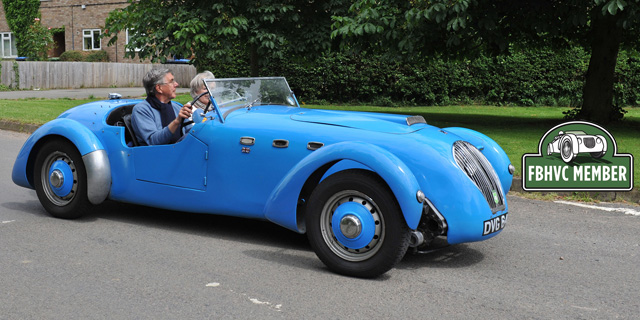Welcome to our FBHVC Page.
The Federation of British Historic Vehicle Clubs represents our interests nationally, fighting for those who enjoy using their Classic Cars.
Robin Astle, our Club's FBHVC representative gives a monthly report on what's going on.

December 2025
by Robin Astle.
From HISTORIC, the FBHVC magazine Issue 7 & 2025 Vehicle Survey
What did the FBHVC ever do for us?
By Andrew W. Fawkes
In the Monty Python film 'Life of Brian' the question, "What have the Romans ever done for us?" results in a list including the viaduct, sanitation, roads... wine! It somewhat undermined the protest being fomented by John Cleese's character. It's a similar question that's sometimes raised by car clubs and members when their annual subscription is due for the Federation of British Historic Vehicle Clubs (FBHVC).
Firstly, what does it cost?
For most clubs the fee is 71p per member, and so for a club with 350 members, that works out around £250 p.a.
What does that buy us?
There is a page on the Federation's website that lists; Free Listing of All Events; Access to FBHVC Insurance; Access to the Club Liability Insurance Scheme; Access to Expert Advice; and the Right to use the FBHVC Logo and attend/vote at general meetings... and, of course, Historic magazine.
But what's the real benefit?
Did you know that it's thanks to the FBHVC that you pay no road tax on your car if it's 40 years old or more? Did you know that the same applies to your MOT exemption? Did you know that Drive It Day was created by the Federation? There is more, and the reason for these is the raison d'etre of the Federation: to maintain the freedom to use yesterday's vehicles on tomorrow's roads.
To achieve this, the Federation has two aces up its sleeve: 1) a unique and influential relationship with the All-Party Parliamentary Historic Vehicles Group, and 2) a board of expert volunteer directors who scour the political, social and economic landscape for trends that might affect or disaffect our passion. The Federation has specialists in law, fuels, research, events, trades, skills, museums, archiving, communications, finance, the DVLA and special projects. All these people give their time freely and share our passion for historic vehicles (that includes military vehicles, motorcycles, buses, coaches, steam powered vehicles and of course classic cars).
All the above are referenced or illustrated in each edition of Historic magazine, as exemplified in this quote from the Legislation update in the last issue: "As I have said before, curtailment of our freedom to use our vehicles is likely to be incidental to other policy aims, unintended and so imperceptible as to be almost unnoticed. We remain watchful, of course."
There is more, much of which can be found at fbhvc.co.uk.
So, what has the FBHVC ever done for us? Apart from the law, tax, influencing, Drive It Day, fuels, research...
More from the MSMT
Book Review by Ian Kerr MBE
The Michael Sedgwick Memorial Trust is a charitable organisation that exists to encourage the recording and publication of motoring history. A not-for-profit organisation, it was established in 1983 in memory of Michael C. Sedgwick, one of the world’s most respected motoring writers and automotive historians.
Twenty-five years ago, the trust commissioned a series of recorded interviews with the ‘backroom boys’ of the motor business, including:
- Roger Menadue – Right hand man to Donald Healey
- Alex Moulton – Collaborator with Alec Issigonis on the design of the Mini’s Hydrolastic suspension and later inventor of the eponymous bicycle.
- Theo Sherwen – Engineer and draughtsman who worked on the Squire sports car 1935-6.
- Ken Smith – A key figure in Citroen’s UK production, including development of the DS model.
The above are available, free of charge, as file attachments on application to msedgwickmt@gmail.com.
2025 National Historic Vehicle Survey
The Federation of British Historic Vehicle Clubs (FBHVC) at the AGM in October released its 2025 National Historic Vehicle Survey (NHVS) – the most comprehensive study ever conducted into the UK’s world-leading historic vehicle movement.
The findings reveal a thriving and valuable sector that continues to grow, contributing £7.3bn to the UK economy each year, supporting tens of thousands of skilled jobs, and attracting record numbers of enthusiasts.
Yet while interest in Britain’s motoring heritage is booming, the survey also warns of an ageing owner base and a critical need to fund the training of the next generation of engineers and restorers to preserve the nation’s transport heritage.
A Living Part of Britain’s Heritage
Historic vehicles, from cars to lorries, buses and motorcycles, represent not only engineering excellence but also cultural and social history. The FBHVC survey highlights the sector’s accessibility: over a third of owners earn less than £35,000 a year, showing it remains an inclusive hobby across all backgrounds.
Despite the growing number of vehicles, their limited use means the sector’s environmental footprint remains tiny. Historic vehicles contribute only 0.2% of all UK road mileage, yet generate significant tourism, education and cultural value.
Key Headlines
- Record Growth in Historic Vehicles:The number of historic vehicles registered with the DVLA has risen again to 1,934,178, just shy of the 2 million once forecast for 2025.
- Economic powerhouse:The historic vehicle sector now contributes £7.3 billion annually to the UK economy, with owners spending on average £4,567 per year maintaining and enjoying their vehicles.
- Jobs and businesses:The movement supports 2,700 specialist businesses, collectively employing 34,500 people across restoration, maintenance, parts supply, museums and events. Nearly half (45%) of those businesses now offer, or plan to offer, apprenticeship programmes to pass on vital heritage skills.
- Growing enthusiasm nationwide:The UK is home to an estimated 690,777 historic vehicle owners, and more than 22.7 million adults regard historic vehicles as a vital part of Britain’s heritage.Over 9.7 million people say they would like to own one, and 4.3 million attended a historic vehicle event in the last year – a 100% increase since 2020.
- Minimal road impact:Despite their visibility, historic vehicles account for only 0.2% of all miles driven in the UK, with the average vehicle covering just 837 miles annually.
- Demographics and Future Generations:The average age of an owner has risen to 66, highlighting the importance of engaging younger enthusiasts. Encouragingly, the under-35s now show the most significant interest in historic vehicles, while the introduction of the ‘Youngtimer’ category (vehicles aged 20–30 years) offers an accessible entry point for new enthusiasts.
- Skills and apprenticeships:With over 11.9 million adults agreeing that apprenticeships focused on historic vehicle skills should be available to young people, the FBHVC calls for continued support to sustain these specialist trades for future generations. Businesses echo the call, with 45% already offering or planning training schemes to ensure vital historic skills are passed on.
The full report is available on the FBHVC website.
 Cookie Consent
Cookie Consent


